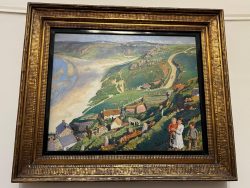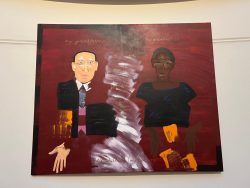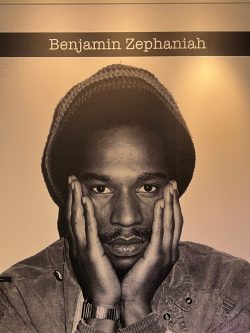We are so back: Visit Birmingham’s Museum of Art today
Recently, I had the opportunity to visit the newly reopened Birmingham Museum and Art Gallery. Having closed due to the pandemic, the Gallery has now been extended and filled with plenty of new exhibits. Although only a portion of the Gallery has reopened, the place was rife with visitors eager to see the new displays, as was I. During my trip to the Museum, I had the pleasure of perusing the Gallery as many times as I liked, thereby making a note of the art I took the most delight in. Upon entering the gallery, visitors are greeted by The Round Room, which is essentially a circular room with various paintings hung up on the walls and the focal statue of Lucifer by Jacob Epstein placed in the statue of the room. Among the paintings, two caught my eye the most.
They have both united upon her canvas and are connected through the eyes of not only their grandchild, but also the many beholders of her artwork

Autumn Sunlight (1922), Laura Knight

My Parents, Their Children (1986), Lubaina Himid
The first was entitled Autumn Sunlight (1922) by Laura Knight, capturing a beautiful autumnal landscape replete with vegetation, cottages, donkeys and the seaside. The painting is cast within the coast of Cornwall, the place of residence for Knight, and one of her favourite places to paint. The second painting I was amused by was called My Parents, Their Children (1986) by Lubaina Himid, depicting an image of the artist’s paternal grandfather and maternal grandmother, illustrating how the two never met but are wistfully connected by their children and grandchildren. In the painting itself is Himid’s writing, explaining how her ‘grandfather never met [her] grandmother,’ yet regardless, they have both united upon her canvas and are connected through the eyes of not only their grandchild, but also the many beholders of her artwork.
Another exhibit I was enticed by was the display of Benjamin Zephaniah’s poetry. For some context, Benjamin Zephaniah was a British writer, born in Birmingham, popular within the African-Caribbean and Asian community for his poetry that draws on his experiences of racism, imprisonment and his Jamaican heritage. His exhibit presented one of his poems by the name of ‘The Big Bang’.
Even the overlooked members of society hold a great significance to the overall ethos within it

Benjamin Zephaniah, as presented at Birmingham’s Museum of Art
The poem is Zephaniah’s reflection on the Handsworth Riots with a focus on the most vulnerable figures in Birmingham. Despite an echo of suffering throughout the poem, there is still an undeniable notion of revolt and change that Zephaniah is advocating for. I would like to bring particular attention to the line ‘The Theory of Everything leaves a lot to be desired’, which to me, suggests the poet’s call to his readers to not be afraid to question pre-established power structures and ways of thinking. I also liked the line ‘the postman taught me that everything needs poetry,’ perhaps illustrating how even the overlooked members of society hold a great significance to the overall ethos within it.
I would recommend the Gallery to anyone even slightly intrigued by art, poetry and compelling voices
After walking through the Gallery a few times, I had the joyful opportunity to interview several other visitors within the Museum. I was intrigued by their own opinions of the exhibits and what inspired them to visit the Gallery. The first couple I spoke to, Lin and Roy, who had frequented the Gallery before its initial closure and were excited by the reopening. Roy did not have a particular favourite display but stated that he was most interested in the cases of artefacts produced in Birmingham. Lin liked the ‘Modern Muse’ exhibit, which was a series of photographic portraits revering the identities and challenges of young South Asian women from Birmingham, as well as the Benjamin Zephaniah display. I then spoke to a lovely pair of women, Christina and Susan, who were also interested in the Museum’s evolution since the reopening and were resultantly surprised by how many exhibits were on display. They were both delighted by the architectural displays that showed how the people of Birmingham used to live and what their furniture was like. Finally, the last individual I spoke to, Alison, mostly enjoyed the sculpture of Madame Renoir, found in the entrance of the Museum, due to its lifelikeness.
That concluded my visit to the Museum, which overall captured the general ethos of Birmingham through the cultural diversity. This was portrayed within majority of the exhibits, and was an inspiration to me as a South Asian writer. Some final paintings laced throughout the gallery that I enjoyed were The Wild Swans (1928) by Arthur Gaskin and The Virtues by William Eginton. On exiting the Museum, I bought myself a postcard with Woman Holding a Flower by Gwen John, another painting I appreciated. I would recommend the Gallery to anyone even slightly intrigued by art, poetry and compelling voices.

Comments